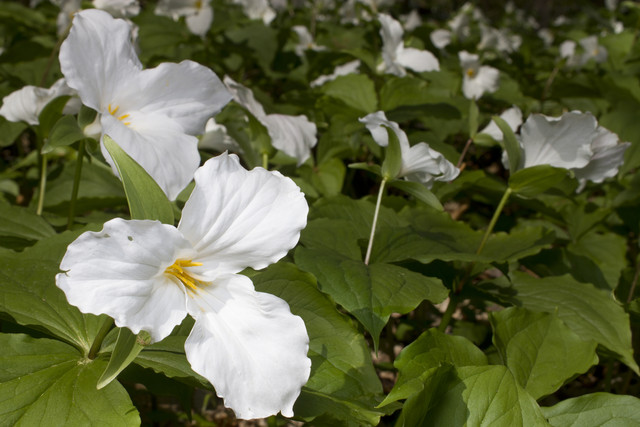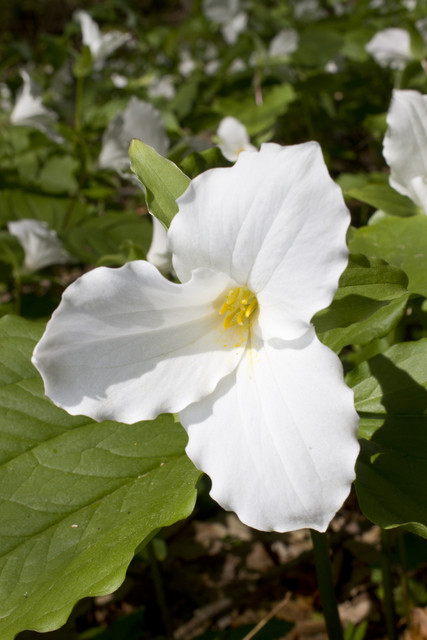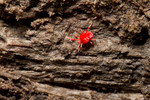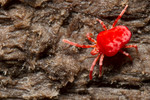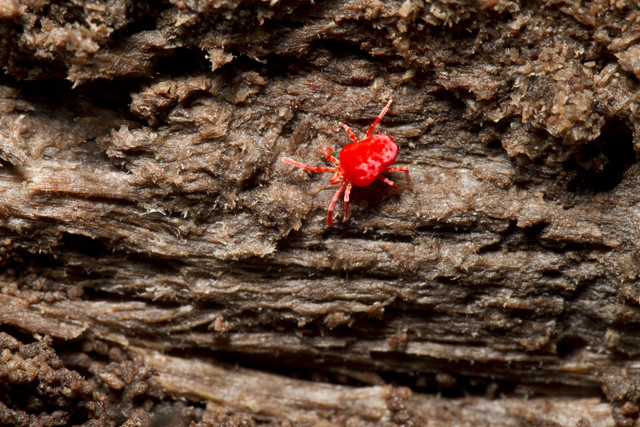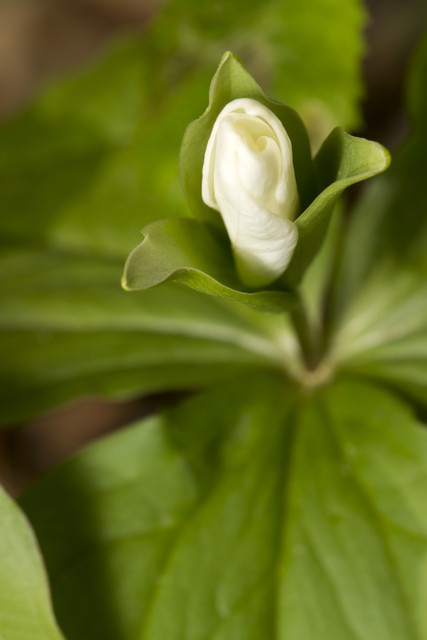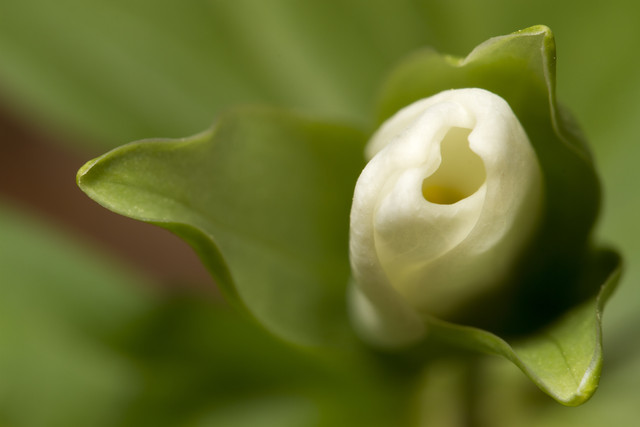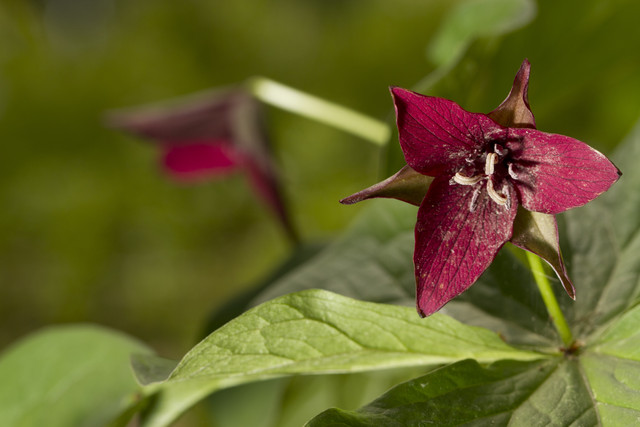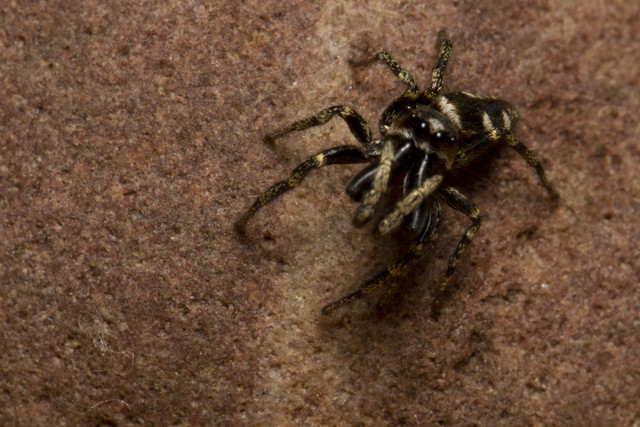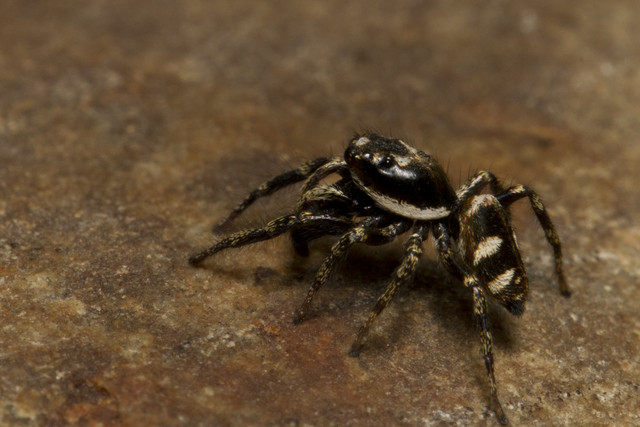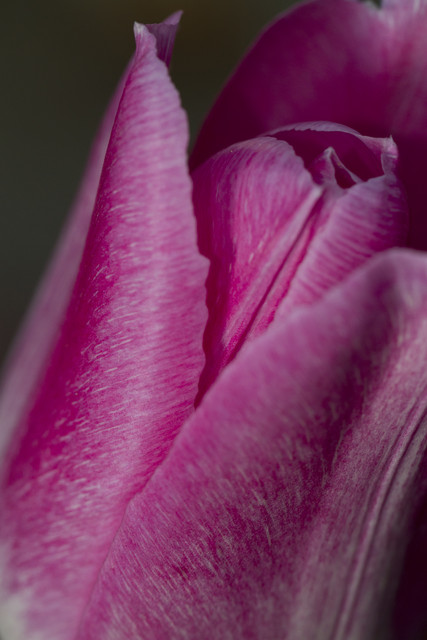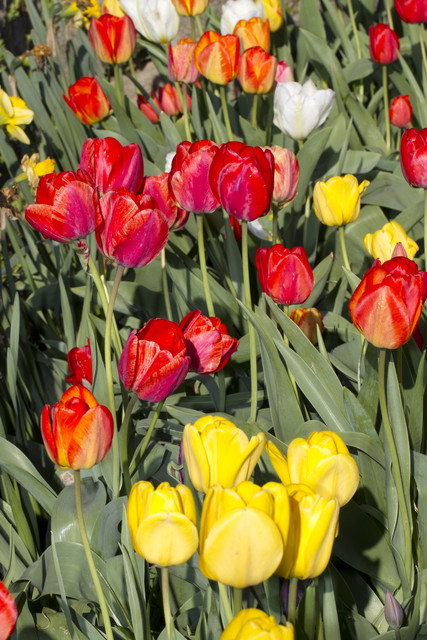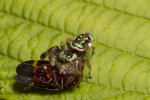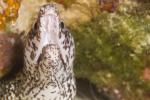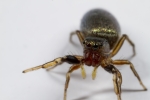flash
Trillium Trails: Sea of Trilliums
ktuli — Wed, 05/04/2011 - 19:04
Sorry, I think I promised I would share this yesterday, but I guess I was just too excited to share that tiny velvet mite that I forgot. I guess to make up for the bait-and-switch and since it seems to be a theme, I'll just share a pair of photos today with not too much blabbering.
Technical Data: Canon EOS 7D, Tokina AT-X M35 Pro DX AF 35mm f/2.8 Macro 1:1, 1/250 sec at f/16. Canon Speedlight 580EX II flash in auto mode and wireless control. Image Stabilization on. ISO 200. RAW processing and cropped in Adobe Camera Raw. Trillium Trails, Fox Chapel, PA.
Technical Data: Canon EOS 7D, Tokina AT-X M35 Pro DX AF 35mm f/2.8 Macro 1:1, 1/250 sec at f/16. Canon Speedlight 580EX II flash in auto mode and wireless control. Image Stabilization on. ISO 200. RAW processing and cropped in Adobe Camera Raw. Trillium Trails, Fox Chapel, PA.
I really wanted to capture the look of a field of the trilliums, but was hitting several problems. First, there were very few areas without large distractions like downed trees or uneven flower coverage or uneven lighting. Then when I did manage to find a fairly decent area of flowers, the shots just looked drab and boring. So I flipped to my Tokina 35mm macro lens and captured the shots you see above. Bringing one of the trilliums large in the foreground with the wide view of the 35mm lens allowing for a nice background showing just how many were around.
Drop me a line and let me know what you think.
- Bill
Trillium Trails: Red Velvet Mite
ktuli — Tue, 05/03/2011 - 20:41
As I was walking along, I was on the lookout for any bugs. At one point, I looked at this decaying log and saw this absolutely tiny bright red dot crawling about. I got down closer and noticed it was a bug of some sort - it had eight legs but didn't look like a spider.
I took maybe half a dozen shots, and ended up only keeping one (others were in focus and decent shots, but the subject was not facing the right way or didn't line up as well as this shot).
It turns out, this is probably a Red Velvet Mite. When I say it was tiny, I mean it. If my measurements and math are correct (using the Exit data saying that my subject distance was 0.29m which would be 1:1 magnification on my 100 f/2.8L lens), it was about 2.5-3mm long.
Below are the original and a cropped version. If you look closely, you can see an additional even tinier arthropod a small distance above the mite's front right leg (in the cropped version, it is just below the top edge of the frame).
Technical Data: Canon EOS 7D, Canon EF 100mm f/2.8L Macro IS USM, 1/250 sec at f/11. Canon Speedlight 580EX II flash in auto mode and wireless control. Image Stabilization on. ISO 200. RAW processing and cropped in Adobe Camera Raw. Trillium Trails, Fox Chapel, PA.
Sorry if that freaked anybody out, but I really like the challenge of working on such tiny subjects.
- Bill
Trillium Trails: White Trillium Bud
ktuli — Mon, 05/02/2011 - 20:14
When we visited the park the other day, almost every trillium in the area was fully bloomed, so when we spotted this bud, it made for a nice alternative to the rest of the shots I was getting. I (intelligently) shot both horizontal and vertical views of the bud, so we'll review both of them today.
We'll start with the vertical shot. Here I wanted to use the larger leaves to provide a nice background, but to still maintain some definition of their patterns, particularly on the one at the bottom of the frame.
Technical Data: Canon EOS 7D, Canon EF 100mm f/2.8L Macro IS USM, 1/250 sec at f/11. Canon Speedlight 580EX II flash in auto mode and wireless control. Image Stabilization on. ISO 200. RAW processing and cropped in Adobe Camera Raw. Trillium Trails, Fox Chapel, PA.
Why This Photo: Given a partially open bud in seas of trilliums in full bloom (tune in tomorrow for more on that), I simply couldn't pass up the opportunity. The initial shape of the bud with the petals wound together in a rather tall vertical bud to me warranted the vertical format.
What Works: The exposure is well balanced - keeping detail even in the white petals of the bud, and the focus is sharp at the closest edges of the flower and surrounding leaves. The depth of field with an aperture of f/11 is just barely enough to keep the bud in clarity, but blurs everything else softly - though maintaining enough clarity to show the vein pattern in the front leaf.
What Doesn't Work: The brown ground showing between the leaves is somewhat distracting, but not nearly as bad as the stray leaf from a neighboring plant in the bottom left corner. The bruise on the leaf to the upper left is a little distracting as well, and a slightly different angle may have hid that behind the flower. If that had been properly hidden, more depth of field might have worked better to show the leaf patterns better.
Before we move on to the horizontal photo, there are a couple items I want to point out.
First, when people see a trillium for the first time, they often assume that the name comes from the three petals to the flower. Which is partially correct, but if you notice, everything on this plant is in sets of threes. Often times the petals of the flowers are so spectacular that they over shadow the fact that the leaves enclosing the bud until it blooms are in a set of three, as are the leaves further down the stem. It is this repeated sets of three pattern that gives the plant its name, and I feel these shots with the flower still closed help to illustrate that a little better.
Another item of note between these two photos is how focal distance - the distance from the camera to the subject - affects depth of field. All other factors being equal, the further you are from a subject, the greater your depth of field. In these examples, the vertical shot has a focal distance of 0.39 meters, whereas the horizontal is only 0.30 meters - a difference of only 0.09 meters or just over 3.5 inches. However, where the vertical shot is able to keep the entire flower bud in clarity, the horizontal shot is barely able to show half of the bud before the depth of field causes it to blur. In all fairness though, there is one other factor at work here, and that is a slightly different angle. The vertical shot uses a more glancing angle to keep more of the bud in the crisp depth of field, whereas the horizontal shot exaggerates the depth of field by being shot straight on. Still interesting to see how a slight reposition of the camera can have such a dramatic effect with the exact same settings.
Anyway... on to the horizontal shot.
Technical Data: Canon EOS 7D, Canon EF 100mm f/2.8L Macro IS USM, 1/250 sec at f/11. Canon Speedlight 580EX II flash in auto mode and wireless control. Image Stabilization on. ISO 200. RAW processing and cropped in Adobe Camera Raw. Trillium Trails, Fox Chapel, PA.
Why This Photo: After shooting the bud in the vertical format, I felt I still wanted to work with this subject a bit more, and thought I would try a horizontal. To eliminate some of the distractions that the same positioning as the vertical would have provided, I moved in closer and took a more intimate view of the bud.
What Works: Again, the focus is sharp right on the closest edges of the bud and leaves, and this time the closer perspective and straight angle reduces the depth of field down to its shortest amount for this aperture setting. Doing so reduces distractions and places all of the viewers attention right on the point of focus. The one leaf opening slightly more than the others perfectly lent itself to the off-set positioning, and this time, the brown ground showing through the further leaves helps to delineate things and avoid everything blurring together. Top it all off with the slight yellow glow of the pollen inside the bud.
What Doesn't Work: Honestly, I feel hard pressed to find anything wrong with this shot. The simplicity of the macro shot helps to reduce distracting issues. Perhaps the two yellowish bands directly below the bud are distracting, but that's really nit-picking.
I don't know, maybe I'm being a little over-protective of my own image, or I'm just missing the problems with it. Please, if you spot anything you don't like about it, drop me a comment and let me know. I'm always open to constructive criticism.
With how fleeting spring wild flowers are, it will probably be next year before I could even attempt to reshoot this, which adds to the challenge. Capturing this atypical view of such an iconic Pennsylvania flower gives a fresh look at something that quite often gets overlooked by many despite its absolute stunning beauty.
Be sure to stop back tomorrow as I will be sharing shots from this little outing all week (as long as I can keep myself motivated to type up the posts each night!). Thanks for dropping in, and feel free to leave a comment with your thoughts or critiques.
- Bill
Trillium Trails: Red Trillium (part 1)
ktuli — Mon, 05/02/2011 - 07:15
Ok - sorry, can't give this photo a full critique (took me a little too long to process the bunch last night, so just doing a quick post this morning).
For those that were on the trip, hopefully you found these (or other) red trillium (at least I think they are reds, I'll have to do a detailed species check later). We found them at the far end of the one trail, and by the time we made it back to the parking area, everyone had gone, so we couldn't share our find.
Technical Data: Canon EOS 7D, Canon EF 100mm f/2.8L Macro IS USM, 1/250 sec at f/8. Canon Speedlight 580EX II flash in auto mode and wireless control. Image Stabilization on. ISO 200. RAW processing and cropped in Adobe Camera Raw. Trillium Trails, Fox Chapel, PA.
Stop back tomorrow as I'll try getting to a more structured post.
- Bill
Flashy Jumping Spider
ktuli — Fri, 04/29/2011 - 19:42
I found this little guy at work today. No lie! He was crawling along my desk, so I scooped him up in a small plastic container I keep at work for just these purposes (yeah, I know - I'm a little bit weird like that). I brought him home, and tried setting up to get some shots of him. He doesn't like to sit still, so I only managed two decent ones before I decided to let him go back to sleep for the night. I might try a couple more tomorrow and then release him when it is nice and warm outside.
Technical Data: Canon EOS 7D, Canon EF 100mm f/2.8L Macro IS USM, 1/200 sec at f/16. Canon Speedlight 580EX II flash in auto mode and wireless control. Image Stabilization on. ISO 400. RAW processing and cropped in Adobe Camera Raw.
Technical Data: Canon EOS 7D, Canon EF 100mm f/2.8L Macro IS USM, 1/200 sec at f/16. Canon Speedlight 580EX II flash in auto mode and wireless control. Image Stabilization on. ISO 400. RAW processing and cropped in Adobe Camera Raw.
Both shots are just a tad off on their focus. The first one would have done better to be focused on his face, but unfortunately, I was not expecting him to twist towards me like that and was focused more on his back. Like I said - he just didn't want to sit still.
Oh well, I'll keep trying.
- Bill
Pink Tulip Close-Up
ktuli — Thu, 04/28/2011 - 21:46
Sorry, don't feel much like typing tonight, so just going to share another macro photo with flash... unfortunately, there aren't many bugs out yet, so we're still working on the flowers.
Technical Data: Canon EOS 7D, Canon EF 100mm f/2.8L Macro IS USM, 1/250 sec at f/5. Canon Speedlight 580EX II flash in auto mode and wireless control. Image Stabilization on. ISO 400. RAW processing in Adobe Camera Raw.
This weekend I am heading out to hopefully get some shots of trillium. But secretly I'm hoping to find some bugs too!
Stay tuned.
- Bill
Macro Quince
ktuli — Tue, 04/26/2011 - 21:13
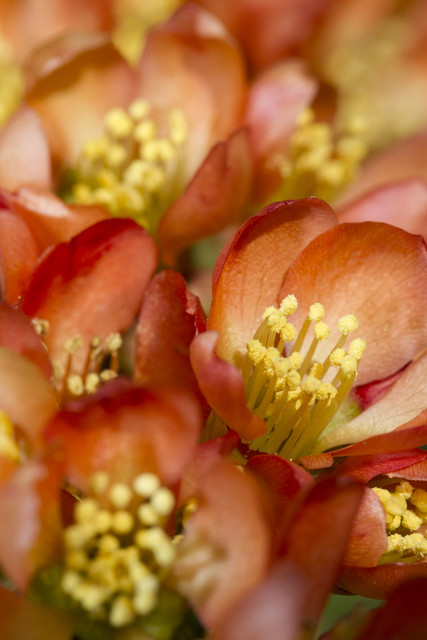
I suppose we'll continue the macro flower shots
I shared another shot of quince blossoms from last spring. This year, I used my new flash and 100mm f/2.8L macro lens to get in a lot closer to blossoms.
Technical Data: Canon EOS 7D, Canon EF 100mm f/2.8L Macro IS USM, 1/100 sec at f/11. Canon Speedlight 580EX II flash in auto mode. Image Stabilization on. ISO 200. RAW processing in Adobe Camera Raw.
Why This Photo: More macro and new flash work.
What Works: The tack sharp focus on the pollen covered stamens is a nice balance with the blurred foreground and background produced by the fairly shallow depth of field. Also, having the in-focus blossom off-centered in the shot is appealing. The entire shot being filled with blossoms prevents there being distracting elements in the frame.
What Doesn't Work: The in-focus blossom breaks the edge of the frame, and ideally should have been kept within the frame. Additionally, the bottom edge of the frame is somewhat darker than the rest - perhaps due to a slightly mis-aimed flash.
I really like bright orange color that pervades this entire shot. On top of that, the very close look at a small flower that could easily be overlooked provides a nice illustration of a tiny pattern in nature.
What do you think?
- Bill
Macro Tulip
ktuli — Mon, 04/25/2011 - 20:50
So with another break in the rain today, I decided to take the camera and my new flash (more on that soon) and flash bracket out and see what else I could get. I find tulips hard to shoot singly as their size proportions just make them difficult to capture. So I decided to aim the flash flight inside the flower and work on a macro view.
Technical Data: Canon EOS 7D, Canon EF 100mm f/2.8L Macro IS USM, 1/13 sec at f/16. Canon Speedlight 580EX II flash in auto mode and wireless control. Image Stabilization on. ISO 200. RAW processing in Adobe Camera Raw.
Why This Photo: Honestly, I was just playing with the new flash in wireless mode and seeing how well the flash bracket worked. Well, that and what I said above about tulips being hard to shoot.
What Works: The bright colors seem to pop, and the placement of the stigma and stamen off-center is nice. The focus resting right on those pollen covered stamen provides a good counter balance with their rough surface compared to the smooth petals of the tulip.
What Doesn't Work: Because of the flash, the reflection of the red color from the flower is picked up on the stigma (the center piece of the flower). Additionally, the right edge of the frame has part of the petal curling back into the shot - with the depth of field it is fairly blurred, but still is a little distracting.
Drop me a line and let me know what you think.
- Bill
Spring Color
ktuli — Sat, 04/23/2011 - 21:55
Just stopping by to share some spring color.
Technical Data: Canon EOS 7D, Canon EF 100mm f/2.8L Macro IS USM, 1/120 sec at f/16. Canon Speedlight 580EX II flash in auto mode. Image Stabilization on. ISO 200. RAW processing in Adobe Camera Raw.
Hopefully this will be a regular sight... if only all those April showers would give us a break.
- Bill
Wakatobi: Pair of Hawkfish
ktuli — Thu, 03/31/2011 - 20:20
Just stopping by to share a couple different hawkfish we encountered while diving in Wakatobi. Enjoy.
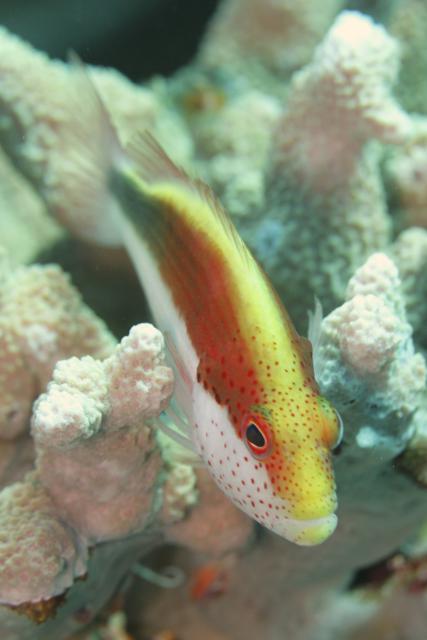
Freckled Hawkfish (Paracirrhites forsteri)
Technical Data: Canon EOS 7D, Canon EF 100mm f/2.8L Macro IS USM, 1/100th sec at f/8. Image Stabilization on. ISO 400 (Auto). Ikelite Housing and Port with Ikelite DS161 Strobe in TTL Mode. Remove color cast and cropped in Photoshop Elements 8.0.
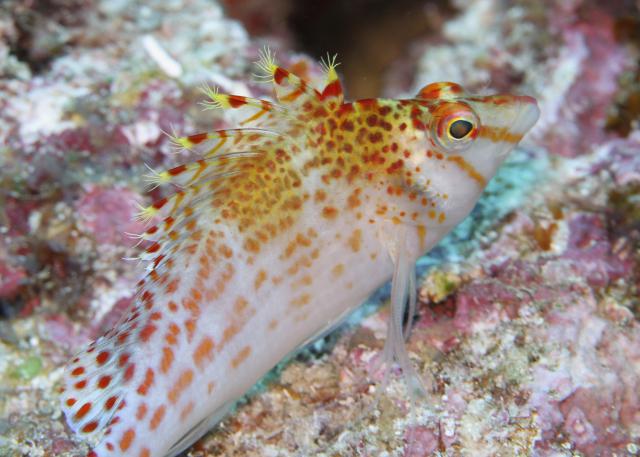
Dwarf Hawkfish (Cirrhitichthys falco)
Technical Data: Canon EOS 7D, Canon EF 100mm f/2.8L Macro IS USM, 1/40th sec at f/8. Image Stabilization on. ISO 400 (Auto). Ikelite Housing and Port with Ikelite DS161 Strobe in TTL Mode. Remove color cast and cropped in Photoshop Elements 8.0.
Some cool little fish, we saw plenty of them on the reefs - especially the dwarf hawkfish whose camouflage allows them to sit right out in the open.
- Bill

